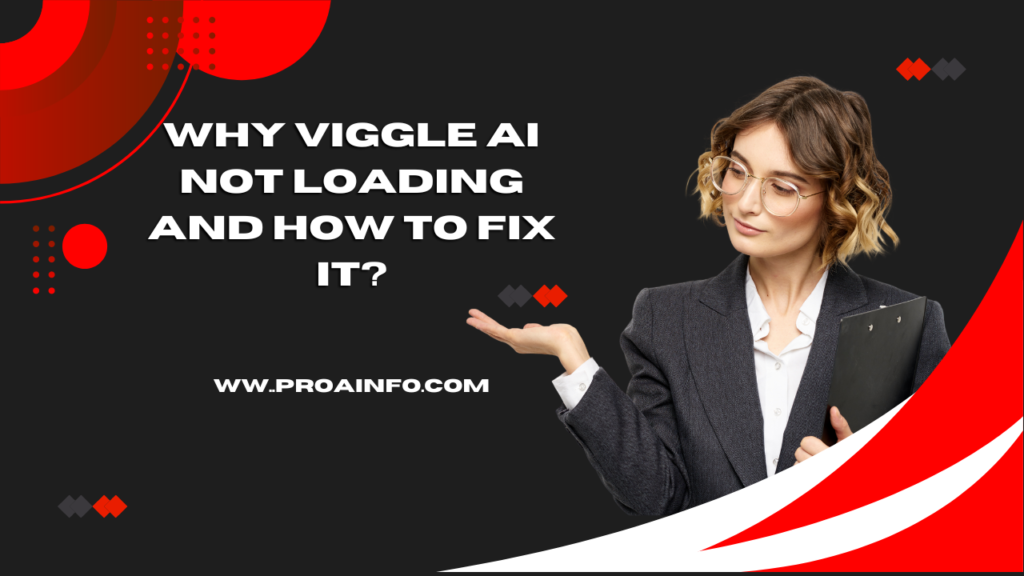Why Viggle AI Not Loading and How to Fix It? Viggle AI is a cutting-edge artificial intelligence system that aims to revolutionize the way we interact with digital media. Developed by a team of renowned computer scientists and engineers, Viggle AI harnesses the power of advanced computer vision and deep learning algorithms to analyze movement patterns within video clips and apply them to still images.
At its core, Viggle AI is designed to bring a new level of dynamism and animation to static photographs. By detecting and replicating the subtle movements and gestures captured in short video clips, the system can breathe life into otherwise motionless images, creating a mesmerizing and immersive experience for the viewer.
Understanding the Mechanics of Viggle AI:
Viggle AI works by leveraging a complex network of neural networks and computer vision algorithms. When a user uploads a video clip, the system analyzes the various movements and gestures performed within the frame, extracting a detailed understanding of the spatial and temporal dynamics at play.
This analysis is then used to create a set of motion vectors and transformation matrices, which are subsequently applied to the user’s still image. The result is a seamless integration of the video’s movements into the static photograph, creating a captivating hybrid that appears to be in constant motion.
The process can be broken down into several key steps:
- Video Preprocessing: The first step involves preprocessing the input video clip, ensuring that it is in a compatible format and resolving any technical issues that may arise.
- Motion Detection and Analysis: Once the video is ready, Viggle AI employs advanced computer vision techniques to detect and analyze the various movements and gestures within the frame. This includes tracking the positions and orientations of key body parts, as well as identifying the overall patterns of motion.
- Motion Vector Extraction: Based on the motion analysis, Viggle AI extracts a set of motion vectors and transformation matrices that describe the dynamics of the video clip. These mathematical representations are the key to integrating the video’s movements into the static image.
- Image Transformation: The final step involves applying the extracted motion vectors and transformation matrices to the user’s still image, seamlessly blending the video’s movements into the photograph. This is achieved through a complex series of image warping and compositing operations, resulting in the captivating hybrid image.
Potential Applications and Benefits of Viggle AI:
The potential applications of Viggle AI are far-reaching and diverse, spanning a wide range of industries and use cases. Some of the most promising applications include:
- Photography and Videography: Viggle AI can revolutionize the way we capture and share visual memories. By adding a new layer of dynamism and animation to still images, the system can transform ordinary photographs into mesmerizing visual experiences.
- Social Media and Digital Advertising: Viggle AI has the potential to revolutionize the way we engage with digital content on social media and in online advertising. By making static images more dynamic and engaging, the system can help businesses and content creators captivate their audiences and drive higher levels of engagement.
- Education and Training: Viggle AI can be leveraged in educational and training contexts, where the ability to bring still images to life can aid in the understanding and retention of complex concepts and processes.
- Entertainment and Creative Expression: The technology underlying Viggle AI can be used to create innovative and visually stunning entertainment experiences, from interactive art installations to dynamic video game environments.
Troubleshooting Viggle AI: Common Issues and Solutions:
Despite the impressive capabilities of Viggle AI, users may occasionally encounter issues that prevent the system from functioning as expected. In this section, we will explore some of the most common problems and provide step-by-step guidance on how to resolve them.
1. Viggle AI Not Loading
One of the most frequent issues users encounter is the inability to load Viggle AI on their devices. This can be caused by a variety of factors, including:
1.1 Compatibility Issues
Viggle AI is designed to work with a wide range of devices and operating systems, but it is possible that your specific hardware or software configuration may not be fully compatible. Check the system requirements and ensure that your device meets the minimum specifications.
1.2 Connectivity Problems
Viggle AI requires a stable internet connection to function properly. Ensure that your device is connected to a reliable network and that your internet speed is sufficient to support the system’s data requirements.
1.3 Browser Compatibility
Viggle AI is optimized for use with the latest versions of popular web browsers, such as Google Chrome, Mozilla Firefox, and Microsoft Edge. If you are experiencing issues with Viggle AI not loading, try accessing the system using a different browser.
1.4 Caching and Cookies
Outdated or corrupted browser caches and cookies can sometimes interfere with the proper functioning of Viggle AI. Try clearing your browser’s cache and cookies, and then attempt to reload the system.
2. Video Compatibility Issues of viggle ai not loading
Another common problem users may encounter is the inability to upload or process certain video formats within Viggle AI. This can be due to the following reasons:
2.1 Unsupported Video Codecs
Viggle AI is designed to work with a wide range of video codecs, but it is possible that the specific codec used in your video clip may not be supported. Check the list of supported video formats and try converting your video to a compatible codec.
2.2 Video Resolution and Aspect Ratio
Viggle AI may have difficulty processing videos that do not meet the system’s recommended resolution or aspect ratio requirements. Ensure that your video clip adheres to the specified guidelines to avoid compatibility issues.
2.3 Video File Corruption
In some cases, the video file itself may be corrupted, preventing Viggle AI from successfully processing the content. Try re-encoding or re-exporting the video clip and then attempting to upload it again.
3. Performance Issues of viggle ai not loading
Viggle AI is a computationally intensive system, and users may encounter performance issues, such as slow processing times or lagging, depending on their hardware and network conditions.
3.1 Hardware Requirements
Viggle AI requires a certain level of computing power and memory to function efficiently. Ensure that your device meets the recommended hardware specifications, and consider upgrading if necessary.
3.2 Network Bandwidth
The processing and application of the motion vectors and transformation matrices within Viggle AI can be data-intensive, especially for high-resolution video clips. Ensure that your network bandwidth is sufficient to support the system’s data requirements.
3.3 Background Tasks and Resource Allocation
Other running applications or background processes on your device may be competing for system resources, negatively impacting the performance of Viggle AI. Try closing any unnecessary programs and ensuring that Viggle AI has access to the appropriate system resources.
4. User Interface and Usability Issues
In some cases, users may encounter problems related to the Viggle AI user interface or overall usability of the system.
4.1 Unclear or Confusing Functionality
If you are having difficulty understanding how to use Viggle AI or access its various features, consult the system’s documentation or reach out to the support team for guidance.
4.2 Accessibility Concerns
Viggle AI should be designed with accessibility in mind, ensuring that users with disabilities can effectively interact with the system. If you encounter any accessibility-related issues, provide feedback to the Viggle AI team so that they can address these concerns.
4.3 Localization and Language Support
Viggle AI may not be available in your preferred language or may not provide a localized user experience. If this is the case, consider providing feedback to the development team to request support for your language or region.
Troubleshooting Strategies and Best Practices of viggle ai not loading
To effectively troubleshoot and resolve issues with Viggle AI, it is essential to follow a structured approach. Here are some general troubleshooting strategies and best practices to keep in mind:
- Check the System Status: Before attempting to resolve any issues, verify that the Viggle AI system is operational and not experiencing any known outages or maintenance periods. Check the system’s status page or community forums for updates.
- Review the Documentation: Carefully read through the Viggle AI documentation, user guides, and knowledge base articles to see if the issue you are experiencing is covered. The documentation may provide step-by-step instructions or troubleshooting tips.
- Identify the Root Cause: Carefully examine the error messages, warning signs, or symptoms you are experiencing to determine the underlying cause of the problem. This will help you focus your troubleshooting efforts on the right areas.
- Isolate the Problem: Try to isolate the problem by testing different components or scenarios. For example, test the video upload process using a different video file or try accessing Viggle AI from a different device or network.
- Check for Updates: Regularly check for updates to the Viggle AI system, as well as updates to your device’s operating system, browser, and other relevant software. Keeping everything up-to-date can often resolve compatibility and performance issues.
- Seek Community Support: If you are unable to resolve the issue on your own, reach out to the Viggle AI community forums or support channels. The development team and other users may be able to provide valuable insights and guidance.
- Provide Detailed Feedback: If you encounter a persistent or unresolved issue, be sure to provide the Viggle AI team with detailed feedback, including any error messages, system information, and steps to reproduce the problem. This will help the development team identify and address the issue more effectively.
By following these troubleshooting strategies and best practices, you can navigate the various issues that may arise with Viggle AI and ensure a smooth and enjoyable user experience.
Conclusion:
Viggle AI is a remarkable technology that has the potential to revolutionize the way we interact with digital media. By seamlessly integrating the movements and gestures captured in video clips into static images, the system creates a captivating and immersive experience that captivates the viewer.
However, as with any complex system, users may encounter various issues and challenges when interacting with Viggle AI. From compatibility and connectivity problems to performance and usability concerns, a wide range of factors can contribute to the system’s functionality.
By understanding the underlying mechanics of Viggle AI, exploring the potential applications and benefits of the technology, and following the troubleshooting strategies and best practices outlined in this article, users can navigate these challenges and take full advantage of the system’s capabilities.
As Viggle AI continues to evolve and expand, the development team remains committed to addressing user feedback and enhancing the overall user experience. With a dedicated community and a shared vision for the future of visual media, Viggle AI is poised to play a transformative role in the digital landscape.







